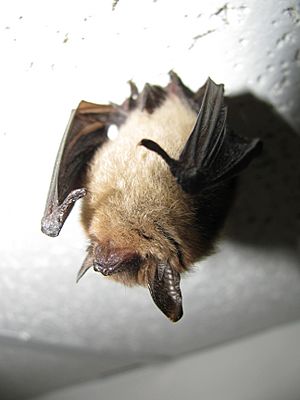Northern myotis facts for kids
Quick facts for kids Northern myotis |
|
|---|---|
 |
|
| Conservation status | |
| Scientific classification | |
| Genus: |
Myotis
|
| Species: |
septentrionalis
|
 |
|
| Range of M. septentrionalis | |
| Synonyms | |
|
Myotis keenii septentrionalis |
|
The northern myotis (Myotis septentrionalis), also called the northern long-eared bat, is a small bat from North America. It's known for its long ears, which help tell it apart from other bats. These bats are usually 3 to 3.7 inches long, with wings that spread out 9 to 10 inches wide. You can find them in the northern United States and southern Canada, stretching across 37 states.
Contents
What Does the Northern Long-Eared Bat Look Like?
The northern long-eared bat is a small bat. It measures about 8.6 centimeters (3.4 inches) long, including its tail, which is about 4 centimeters (1.6 inches) long. Adult bats weigh between 5 and 8 grams, which is about the same as two pennies.
Their fur and wing membranes are light brown. Unlike a similar bat called Keen's myotis, they do not have dark spots on their shoulders. These bats have long ears with a pointed part inside called a tragus. When their ears are folded forward, they reach past their nose. They also have a longer tail and bigger wings than most bats their size. This helps them fly very well, even when flying slowly.
Where Do Northern Long-Eared Bats Live?
Northern long-eared bats live in many parts of eastern United States and Canada. You can find them from Manitoba and Newfoundland in the north, down to North Carolina and Alabama in the south. They are sometimes found in western Canada too, like in British Columbia and Yukon.
These bats mostly live in forests, especially boreal forests. They like to rest in hardwood trees during the summer months.
How Do Northern Long-Eared Bats Live?
Daily Life and Roosting Habits
During spring and summer, northern long-eared bats spend their days resting. They often roost in trees or sometimes in buildings. They usually move to a new roosting spot every other day. These roost trees are often close together, usually within 600 meters (about 2,000 feet) of good places to find food.
Male bats and females that are not having babies roost alone or in small groups. But female bats that are having babies form much larger groups called maternity colonies. These groups can have up to sixty bats.
Hibernation and Winter Homes
In the fall, northern long-eared bats fly to caves to hibernate. Hibernation is like a long, deep sleep for animals during winter. This can happen anytime from September to November, depending on how far north they live. They wake up and leave the caves between March and May.
They often hibernate with many other types of bats. Even so, groups of northern long-eared bats can still number in the hundreds during hibernation.
Hunting and Food
Northern long-eared bats are very good at hunting inside forests. They use echolocation to find their way around. Echolocation means they send out sounds and listen for the echoes to create a picture of their surroundings. Their calls are short, quiet, and high-pitched.
Their main food is moths. But they also eat beetles, flies, and other insects. What's special about them is how they catch food. They often "glean" insects, which means they pick them off surfaces like leaves or tree trunks, instead of catching them while flying. They usually hunt under the forest trees or at the edge of forests. Most of their hunting happens in the first two hours after the sun sets.
Reproduction and Life Cycle
Northern long-eared bats mate between July and early October. Female bats store the male's sperm over the winter. They only become pregnant in the spring.
The baby bats are born between May and early July, depending on where they live. The young bats usually grow to full size by the end of August. These bats can live for over eighteen years in the wild!
Protecting the Northern Long-Eared Bat
The biggest threat to the northern long-eared bat is a disease called white-nose syndrome. This disease has caused a huge drop in their numbers, especially in the northeastern United States. In some areas, their population has gone down by 99%.
Because of white-nose syndrome, the USFWS (United States Fish and Wildlife Service) listed the northern long-eared bat as a threatened species. This means they are at risk of becoming endangered. The USFWS recommended protecting this species under the Endangered Species Act. A final decision was made, and the bat was officially listed as threatened starting May 4, 2015.
There have been efforts to help protect these bats. For example, the Elroy-Sparta Bike Trail in Wisconsin has tunnels where these bats hibernate. These tunnels are closed by early November to protect the bats. This caused some discussion between the U.S. Fish and Wildlife Service and the organizers of the Rails to Trails Marathon. The marathon used to be in November, but it was moved to earlier in October in 2017. This change allowed the tunnels to close earlier, helping to protect the hibernating bats.


